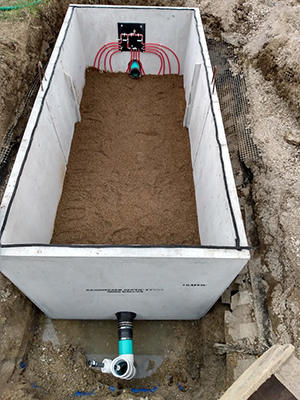Training Modules Available to Help Producers Better Manage Phosphorus Losses
Contact: Jan Suszkiw
Email: Jan.Suszkiw@usda.gov
August 14, 2023
A series of online training modules is now freely available to farmers, engineers, environmental consultants and others interested in designing on-farm systems to remove phosphorus from field runoff or subsurface drainage.
Available on the Internet, the modules comprise seven narrated videos, starting with a basic overview of the need for phosphorus removal systems followed by how to design, build and install them, as well as how to properly dispose of or recycle the absorbent materials used to help capture the nutrient in drainage water and runoff.
“These videos explain the basics, and then get into all the details necessary for designing and constructing phosphorus removal structures,” said Chad Penn, an Agricultural Research Service (ARS) agricultural engineer who coordinated the modules’ development. “The goal is to disseminate this conservation practice throughout the country and world”—helping producers strike an optimal balance between crop productivity and environmental stewardship.
Phosphorus is a critical nutrient for optimal plant growth, health and yield, added Penn, with the ARS National Soil Erosion Research Laboratory in West Lafayette, Indiana. However, phosphorus that leaves agricultural fields in runoff or drainage water can accumulate in bodies of surface water, like rivers and lakes, compromising their quality and triggering the growth and decay of algal blooms that can imperil aquatic life and recreational activities.
Management practices and engineered systems that prevent phosphorus loss are vital to maintaining environmental quality.
 A series of training modules is available to help users build phosphorus-removing structures like this one. (Photo by Chad Penn, ARS)
A series of training modules is available to help users build phosphorus-removing structures like this one. (Photo by Chad Penn, ARS)
However, deciding which system is best for a specific farm operation or crop field configuration can be challenging. Fortunately, the modules can help users navigate their way through the process, as well as provide “lessons learned” from the field, said Penn, who has conducted extensive field research on phosphorus removal systems.
The modules include lessons on using the P-Trap ("Phosphorus Transport Reduction"), a software program that Penn and collaborators developed to help users calculate specifications for building the structure based on the data that’s entered, including expected water-flow rates, annual volume, dissolved phosphorus concentration, drainage ditch depth and slope, pipe diameter and target removal goals.
Penn noted that regardless of design, phosphorus removal structures are intended for use on fields with a legacy, or long history, of phosphorus application in fertilizers or animal manures that has resulted in an accumulation of soil phosphorus to concentrations greater than crops need. The structures’ uses are not a replacement for nutrient management practices but rather a complement to them, he added.
In addition to creating the P-Trap software, Penn also designs, installs and field tests phosphorus removal systems in collaboration with Kevin King of ARS's Soil Drainage Research Unit in Columbus, Ohio; Jay Martin of The Ohio State University, Jessica D'Ambrosio of the Nature Conservancy, Jeremy Freund of Outagamie County Conservation and Santina Wortman of the U.S. Environmental Protection Agency.
The team lent their technical expertise to the American Society of Agronomy (ASA) and the American Society of Agricultural and Biological Engineers (ASABE), which developed the training modules with support from USDA’s Natural Resources Conservation Service.
The Agricultural Research Service is the U.S. Department of Agriculture's chief scientific in-house research agency. Daily, ARS focuses on solutions to agricultural problems affecting America. Each dollar invested in U.S. agricultural research results in $20 of economic impact.
